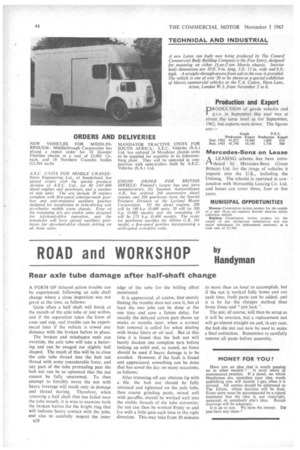ROAD and WORKSHOP "
Page 46

If you've noticed an error in this article please click here to report it so we can fix it.
Handyman
Rear axle tube damage after half-shaft change
A FORM OF delayed action trouble can be experienced, following an axle shaft change where a close inspection was not given at the time, as follows:
Quite often a half shaft will break at the mouth of the axle tube or just within, and if the separation takes the form of cone and cup, real trouble can be experienced later if the vehicle is towed any distance with the broken halves in place.
The broken and misshapen ends can override, the axle tube will take a battering and can be swaged out slightly bell shaped. The result of this will be to close the axle tube thread into the hub nut thread with some considerable force, and any part of the tube protruding past the hub nut can be so upturned that the nut cannot be fully unscrewed. To then attempt to forcibly move the nut with heavy leverage will result only in damage and thread tearing. Therefore; when renewing a half shaft that has failed near the tube mouth, it is wise to examine both the broken halves for the bright ring that will indicate heavy contact with the tube, and also to carefully inspect the inner
B28 edge of the tube for the belling effect mentioned.
It is appreciated, of course, that merely finding the trouble does not cure it, but at least the. two jobs can be done at the one time and save a future delay, for usually the delayed action part shows up weeks or months later, when a normal hub removal is called for when dealing with brake liners or oil seal. But at this time it is found that the hub nut will barely slacken one complete turn before locking up solid and, as stated, no force should be used if heavy damage is to be avoided. However, if the fault is found and appreciated, something can be done that has saved the day on many occasions, as follows: After trimming off any obvious lip with a file, the hub nut should be fully returned and tightened on the axle tube, then coarse grinding paste, mixed soft with paraffin, should be worked well into the visible threads of the tube extremity; the nut can then be worked firmly to and fro with a little gain each time in the right direction. This may take from 30 minutes
to more than an hour to accomplish, but if the nut is worked fully home and out each time, fresh paste can be added, and it is by far the cheaper method than brute force and "pot tuck ".
The nut, of course, will then be scrap as it will be oversize, but a replacement nut will go almost straight on and, in any case, the hub die nut can now be used to make a final correction. Remember to carefully remove all paste before assembly.




































































































